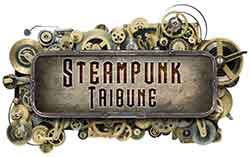Steampunk, a genre that blends Victorian aesthetics with futuristic innovation, inspires a unique culture filled with creativity and imagination. Male steampunk names often reflect this fusion, offering a glimpse into a world where technology meets whimsy and adventure. Choosing the right name can enhance character development in writing, role-playing, or cosplay.

From rugged inventors to dapper gentlemen, the male steampunk names can range from the traditionally British to the whimsically fantastical. Names like Alistair, Thaddeus, and Jasper evoke a sense of history while suggesting layers of personality and intrigue. These names can help set the tone for stories or characters set in a steampunk universe.
As enthusiasts explore this captivating world, the significance of a well-chosen name becomes clear. A name is more than just an identifier; it can encapsulate a character’s background, aspirations, and even their adventures. Understanding the elements that make up compelling male steampunk names will spark creativity and engagement in any steampunk-related endeavor.
Origins of Steampunk

Steampunk emerges from a blend of historical contexts and literary influences. The Victorian era played a pivotal role in shaping the aesthetic and ideologies of steampunk, while early science fiction laid the groundwork for its thematic elements.
Victorian Era Foundations
The Victorian era, spanning from 1837 to 1901, was a time of rapid industrial progress and social transformation in Britain. This period fostered a fascination with technology, invention, and a sense of adventure.
Victorian society embraced steam power, which became a defining feature of the industrial landscape. This fascination is reflected in many steampunk designs, characterized by intricate machinery, brass fittings, and a retro-futuristic style.
Noteworthy aspects include the period’s emphasis on exploration and discovery, influenced by writers like Jules Verne and H.G. Wells. The aesthetics of Victorian clothing, architecture, and art contribute to the steampunk visual language, establishing a rich cultural backdrop for its narratives.
Science Fiction Beginnings
The roots of steampunk can be traced back to early science fiction literature. Works in the late 19th century introduced readers to imaginative worlds powered by steam and clockwork.
Prominent authors such as Mary Shelley and Edgar Allan Poe planted seeds of fantastical storytelling. Their narratives often featured advanced technologies and speculative inventions that would later become hallmarks of the steampunk genre.
In the 1980s, the term “steampunk” was coined as authors began to explicitly combine Victorian aesthetics with speculative fiction. This movement found momentum in works like K.W. Jeter’s novels, which portrayed alternative histories filled with steam-powered devices. The fusion of these influences helped to establish steampunk as a unique subgenre, marked by its distinct look and feel.
Defining the Steampunk Aesthetic

The steampunk aesthetic combines Victorian-inspired fashion with innovative machinery and technology. This unique blend emphasizes both style and functionality, showcasing the imaginative possibilities of the era’s design concepts.
Fashion and Style
Steampunk fashion is characterized by a fusion of Victorian elegance and industrial flair. Typical garments include tailored jackets, waistcoats, and high-collared shirts for men, often adorned with accessories like goggles, pocket watches, and gloves. Fabrics such as leather, lace, and tweed add texture and depth.
Color palettes often gravitate towards earthy tones, bronze, and deep jewel shades. Trousers may be paired with knee-high boots or brocade shoes, enhancing the overall aesthetic. Subcultures within steampunk fashion allow for personal expression, with styles ranging from rugged explorer to sophisticated gentleman.
Machinery and Technology
In the steampunk world, machinery and technology play a central role. Often imagined as steam-powered, gadgets showcase intricate craftsmanship. Examples include beautifully designed clockwork devices, airships, and mechanical automata, all reflecting a blend of art and engineering.
Gears, cogs, and pipes are frequently incorporated into both actual machinery and fashion items. This emphasis on retro-futurism evokes a sense of nostalgia for an imagined past. Steampunk concepts also explore alternative energy sources, enabling fantastical inventions that capture the imagination.
Character Archetypes in Steampunk
Steampunk features a variety of distinctive character archetypes that embody the spirit of adventure and innovation. These figures often navigate a world filled with steam-powered machinery and advanced technology, each contributing to the genre’s unique narrative.
Airship Captains and Explorers
Airship captains serve as charismatic leaders who command their vessels through the skies. They embody the thrill of exploration, often depicted with rugged attire and a keen sense of adventure.
These captains are skilled in navigation, ensuring safe voyages through unpredictable weather and treacherous landscapes. Explorers, on the other hand, may accompany them or operate independently, seeking new frontiers and uncovering lost treasures.
Whether charting unknown territories or battling sky pirates, their stories often highlight themes of courage and curiosity. The airship itself becomes a symbol of freedom and technological marvel, showcasing the imaginative possibilities of steampunk.
Inventors and Scientists
Inventors and scientists are the driving force behind the technological advancements in steampunk narratives. They often possess an insatiable curiosity and a desire to push the boundaries of existing knowledge.
Commonly seen with tools and blueprints, these characters create innovative steam-powered machinery and devices. Their experiments can lead to groundbreaking discoveries, but also to unforeseen consequences, creating tension and conflict.
They explore themes of ethical responsibility in the face of progress, highlighting the balance between invention and morality. The character’s journey typically involves challenges that test their intellect and resolve, making them essential to the steampunk landscape.
Crafting Male Steampunk Names
Creating male steampunk names involves blending creativity with elements that reflect the genre’s unique characteristics. A well-crafted name can add depth, suggest a backstory, and enhance authenticity.
The Role of a Name
In the steampunk genre, names serve more than just identification; they embody the essence of the character. A good steampunk name often reflects Victorian influences, mechanical themes, or an inventive spirit.
Consider using components such as:
- First Names: Traditional or unique, evoking a sense of history. Examples include “Percival” or “Thaddeus.”
- Surnames: Often inspired by machinery or professions, like “Cogsworth” or “Brassington.”
- Titles: Including ranks or professions can add an extra layer, such as “Engineer” or “Inventor.”
The combination creates authenticity and can hint at a character’s history or role in the steampunk world.
Using Generators for Inspiration
Steampunk name generators can be valuable tools for those seeking inspiration. They often combine random names and elements that resonate with the steampunk aesthetic.
Several online generators provide a wide range of options:
- Steampunk Name Generator: Offers a mix of Victorian and mechanical names.
- Fantasy Name Generators: Includes steampunk-themed options among various genres.
Using these generators encourages creativity and helps users discover unique names. When utilizing a generator, it’s advantageous to tweak the output. Adjust the names to better fit the character’s backstory or personality. This personalization enhances authenticity, ensuring the name aligns perfectly with the character’s place in the steampunk universe.
Incorporating Names into the Steampunk Setting
Names in a steampunk context play a crucial role in establishing character identity and enhancing the overall atmosphere of the genre. They should not only sound fitting for the time period but also reflect the character’s personality and backstory.
The Importance of Context
In a steampunk setting, context shapes how names resonate with the audience. Names should evoke imagery consistent with Victorian aesthetics and industrial innovation. For example, a character named Alistair Crowley may suggest a scholarly figure engaged in scientific pursuits, while a name like Jasper Flint could evoke images of a rugged adventurer.
Characters’ names can be enhanced through their roles. Inventors, for instance, could have names that suggest innovation, such as Percival Gearhart. It’s vital to choose names that not only reflect the character’s traits but also resonate within the broader narrative. This coherence strengthens the reader’s immersion in the steampunk world.
Cross-Genre Influence on Names
The fusion of genres in steampunk leads to a rich variety of male names. Elements from fantasy, adventure, mystery, and technology seamlessly blend to create unique and evocative identities that reflect this imaginative world.
Fantasy and Adventure
Fantasy elements contribute significantly to male steampunk names. Names often feature mystical components or an air of nobility. Characters may bear names like Thaddeus, evoking a sense of ancient wisdom, or Balthazar, suggesting a connection to the arcane.
Adventure influences can be seen through names that inspire a sense of exploration. Names like Aldric or Cyrus evoke imagery of brave explorers and intrepid heroes. These choices combine robust syllables with a hint of historical depth, vital for characters embarking on daring quests or facing mythical challenges.
Mystery and Technology
Mystery in steampunk names often includes dark or enigmatic undertones. Names such as Vincent or Lucian may imply intrigue and complexity. They can suggest characters with hidden agendas or shadowy backgrounds, enriching the narrative atmosphere.
Technology also plays a crucial role. Names like Gideon or Archimedes connect to inventiveness and intellect, often associated with scientific innovation. These names reflect the fusion of human ingenuity and mechanical advancements, essential in a steampunk setting where technology drives the story forward.
Creating an Authentic Steampunk Name
An authentic steampunk name embodies the unique aesthetic of the genre, reflecting a blend of creativity and traditional naming styles. It should evoke imagery associated with the Victorian era, industrial elements, and a sense of adventure.
Balancing Creativity with Genre Rules
Creating a male steampunk name requires a balance between inventive expression and adherence to the genre’s conventions. Names often feature a mix of Victorian, fantastical, and mechanical components.
- Victorian Influences: Names that draw from Victorian England create an immediate connection to the period. For instance, names like “Albert” or “Percival” resonate well within this timeframe.
- Mechanical Touch: Incorporating elements that suggest industrial machinery or science can enhance authenticity. For instance, combining names with terms like “Gear,” “Steam,” or “Bolt” adds the necessary flair.
- Inventive Combinations: Mixing traditional names with unique titles or descriptors can yield memorable results. Examples include “Victor Copperfield” or “Gideon Ironclad,” blending creativity with thematic elements of the steampunk aesthetic.
Attention to these details fosters names that reflect the desired authenticity while keeping the creative spirit of the steampunk genre alive.




